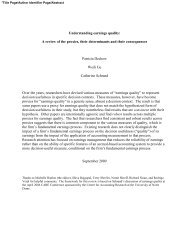Nike Considered: Getting Traction on Sustainability - MIT Sloan ...
Nike Considered: Getting Traction on Sustainability - MIT Sloan ...
Nike Considered: Getting Traction on Sustainability - MIT Sloan ...
You also want an ePaper? Increase the reach of your titles
YUMPU automatically turns print PDFs into web optimized ePapers that Google loves.
NIKE CONSIDERED: GETTING TRACTION ON SUSTAINABILITY<br />
Rebecca Henders<strong>on</strong>, Richard M. Locke, Christopher Lyddy, Cate Reavis<br />
The XX3 was <strong>on</strong>e of the first high-performance examples of <str<strong>on</strong>g>Nike</str<strong>on</strong>g>’s <str<strong>on</strong>g>C<strong>on</strong>sidered</str<strong>on</strong>g> strategy, the name<br />
given to its sustainable design ethos. As Sarah Severn, a director of Corporate Resp<strong>on</strong>sibility at <str<strong>on</strong>g>Nike</str<strong>on</strong>g>,<br />
noted,<br />
We needed to adopt the <str<strong>on</strong>g>C<strong>on</strong>sidered</str<strong>on</strong>g> principles into mainstream product, which is now happening<br />
with the Jordan XX3. After many years that’s the Holy Grail that we’re finally starting to get<br />
tracti<strong>on</strong> <strong>on</strong>. We recognized in the 1990s that design was the key, but we didn’t have the skill-set<br />
in the envir<strong>on</strong>mental team to translate what we knew about envir<strong>on</strong>mental issues in a way that<br />
designers understood. Part of the problem was we didn’t have tools in place. But now what you<br />
see with the <str<strong>on</strong>g>C<strong>on</strong>sidered</str<strong>on</strong>g> Index is that for the first time, we have a tool that helps designers make<br />
envir<strong>on</strong>mental choices about how they design their product.<br />
Scenario planning <strong>on</strong> Corporate Resp<strong>on</strong>sibility-related global trends such as water, health, and<br />
energy, al<strong>on</strong>gside increasing worldwide c<strong>on</strong>cern about climate change, had fueled <str<strong>on</strong>g>Nike</str<strong>on</strong>g>’s worries<br />
about the company’s supply chain. As with most industries, <str<strong>on</strong>g>Nike</str<strong>on</strong>g> realized that it was heavily<br />
dependent <strong>on</strong> oil for materials and fossil fuel energy, and was potentially exposed to high oil prices<br />
and looming carb<strong>on</strong> restricti<strong>on</strong>s from anti-climate change regulati<strong>on</strong>. Meanwhile its waste producti<strong>on</strong><br />
and use of toxic materials and water also posed major risks.<br />
In December 2004, incoming Corporate Resp<strong>on</strong>sibility (CR) VP Hannah J<strong>on</strong>es recognized that <str<strong>on</strong>g>Nike</str<strong>on</strong>g><br />
needed to be strategic in its resp<strong>on</strong>se to its envir<strong>on</strong>mental impacts, keeping in mind how ineffective<br />
<str<strong>on</strong>g>Nike</str<strong>on</strong>g>’s initial reacti<strong>on</strong> to accusati<strong>on</strong>s of abuse at its c<strong>on</strong>tracted supplier factories had been in the<br />
1990s. But how could <str<strong>on</strong>g>Nike</str<strong>on</strong>g> best do this? Was <str<strong>on</strong>g>C<strong>on</strong>sidered</str<strong>on</strong>g> a good first step? What else might be<br />
required?<br />
<str<strong>on</strong>g>Nike</str<strong>on</strong>g> 2<br />
In 2008, with nearly 50,000 product styles across its three product lines, <str<strong>on</strong>g>Nike</str<strong>on</strong>g> Inc., which included<br />
the <str<strong>on</strong>g>Nike</str<strong>on</strong>g>, C<strong>on</strong>verse, Cole Haan, Umbro, and Hurley brands, was the world’s leading branded athletic<br />
footwear, apparel, and equipment company. The <str<strong>on</strong>g>Nike</str<strong>on</strong>g> brand, a subsidiary of <str<strong>on</strong>g>Nike</str<strong>on</strong>g> Inc., was organized<br />
around more than 30 product categories resp<strong>on</strong>sible for designing, developing, and marketing<br />
products for c<strong>on</strong>sumer niches, such as Running and Basketball. Categories housed key support<br />
functi<strong>on</strong>s like product engineers and innovators, and maintained c<strong>on</strong>necti<strong>on</strong>s to <str<strong>on</strong>g>Nike</str<strong>on</strong>g>’s factory liais<strong>on</strong><br />
offices and sales and marketing functi<strong>on</strong>s. Categories depended <strong>on</strong> factories’ expertise in managing<br />
producti<strong>on</strong> processes, which allowed them to focus <strong>on</strong> product creati<strong>on</strong> and marketing.<br />
In FY08, <str<strong>on</strong>g>Nike</str<strong>on</strong>g> Inc. earned $18.6 billi<strong>on</strong> in revenues, of which the <str<strong>on</strong>g>Nike</str<strong>on</strong>g> brand accounted for $16<br />
billi<strong>on</strong> (86%), with the remaining $2.6 billi<strong>on</strong> accounted for by affiliate brands like C<strong>on</strong>verse and<br />
Hurley. Footwear represented 61% of <str<strong>on</strong>g>Nike</str<strong>on</strong>g> brand revenues, followed by apparel with 33%, and 7%<br />
2 This secti<strong>on</strong> draws heavily from Richard M. Locke, “The Promise and Perils of Globalizati<strong>on</strong>: The Case of <str<strong>on</strong>g>Nike</str<strong>on</strong>g>,” in Thomas A. Kochan<br />
and Richard L. Schmalensee, ed., Management: Inventing and Delivering Its Future (<strong>MIT</strong> Press, Cambridge MA, 2003).<br />
January 21, 2009 2
















